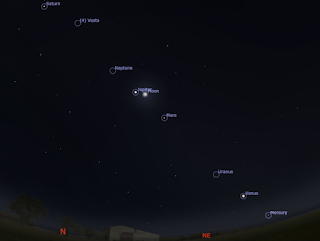Wednesday, June 08, 2022
All Five bright Classical Planets in the Morning sky in rare line-up (10-30 June, 2022)
| Morning sky on Sunday June 12 as seen from Adelaide at 5:50 am ACST (90 minutes before sunrise). Saturn, Jupiter, Mars, Venus and Mercury form a line (Uranus, Neptune and the Asteroid Vesta are in the line too, but all need at least binoculars to see). Venus and Uranus are at their closest.The inset shows the binocular appearance of Venus and Uranus at this time. Similar views will be seen from the rest of Australia at the equivalent local time (90 minutes before sunrise, click to embiggen). | Morning sky on Sunday June 19 as seen from Adelaide at 5:52am ACST (90 minutes before sunrise). The waning Moon is near Saturn. Similar views will be seen from the rest of Australia at the equivalent local time (90 minutes before sunrise, click to embiggen). | Morning sky on Wedensday June 22 as seen from Adelaide at 5:53 am ACST (90 minutes before sunrise). The waning Moon is near Jupiter. Similar views will be seen from the rest of Australia at the equivalent local time (90 minutes before sunrise, click to embiggen). |
| Morning sky on Thursday June 23 as seen from Adelaide at 5:53 am ACST (90 minutes before sunrise). The crescent Moon is near Mars.The inset shows the binocular appearance of the Moon and Mars at 3:00 am local time. Similar views will be seen from the rest of Australia at the equivalent local time (90 minutes before sunrise, click to embiggen). | Morning sky on Saturday June 25 as seen from Adelaide at 5:53 am ACST (90 minutes before sunrise). The Moon and and Uranus are at their closest (occultation in WA, NT and FNQ). The inset shows the binocular appearance of the Moon and Uranus at this time. Similar views will be seen from the rest of Australia except the occulting states at the equivalent local time (90 minutes before sunrise, click to embiggen). | Morning sky on Sunday June 26 as seen from Adelaide at 6:24 am ACST (60 minutes before sunrise). The crescent moon forms a line with Venus, Aldebaran and Mercury, with the Pleiades cluster close by. Similar views will be seen from the rest of Australia at the equivalent local time (60 minutes before sunrise, click to embiggen). |
Over the next three weeks you will be able to see a rather rare sight, if you have clear morning skies. All 5 bright classical planets are lined up in the order they are from the Sun. Mercury, Venus, Mars, Jupiter and Saturn. In February 2016 we also had 5 bright planets in the morning skies but the lineup was Mercury, Venus, Saturn, Mars and Jupiter. We have to go back 21 December 2004 to have all 5 planets in the morning sky in solar order.
Also, unlike the other times we had all the bright classical planets together in the morning, we also have all the other planets (Uranus, Neptune), the Dwarf planet Pluto and the Asteroid 4 Vesta. These are not is solar system order.
To make up for this on the 12th we have a close approach of Venus and Uranus. The Moon joins the line-up from the 19th, and we have lots of nice close Moon approaches, with the Moon and Uranus being close on the 25th and occultations in Cairns (Dawn), Darwin, Alice Springs and Perth.
On the 26th Venus and the thin crescent Moon are close, the Pleiades and Aldebaran and Mercury make this an attractive sight. On the 27th the thin crescent Moon forms a rectangle with Mercury, Venus and Aldebaran. On the 30th Venus forms a second eye for Taurus the Bull.
Labels: 4 Vesta, Jupiter, Mars, Mercury, Neptune, Occultation, Saturn, unaided eye, Uranus, Venus









 Click to read about or order
Click to read about or order Click to read about or order
Click to read about or order Click to read about or order
Click to read about or order Click to read about or order
Click to read about or order




